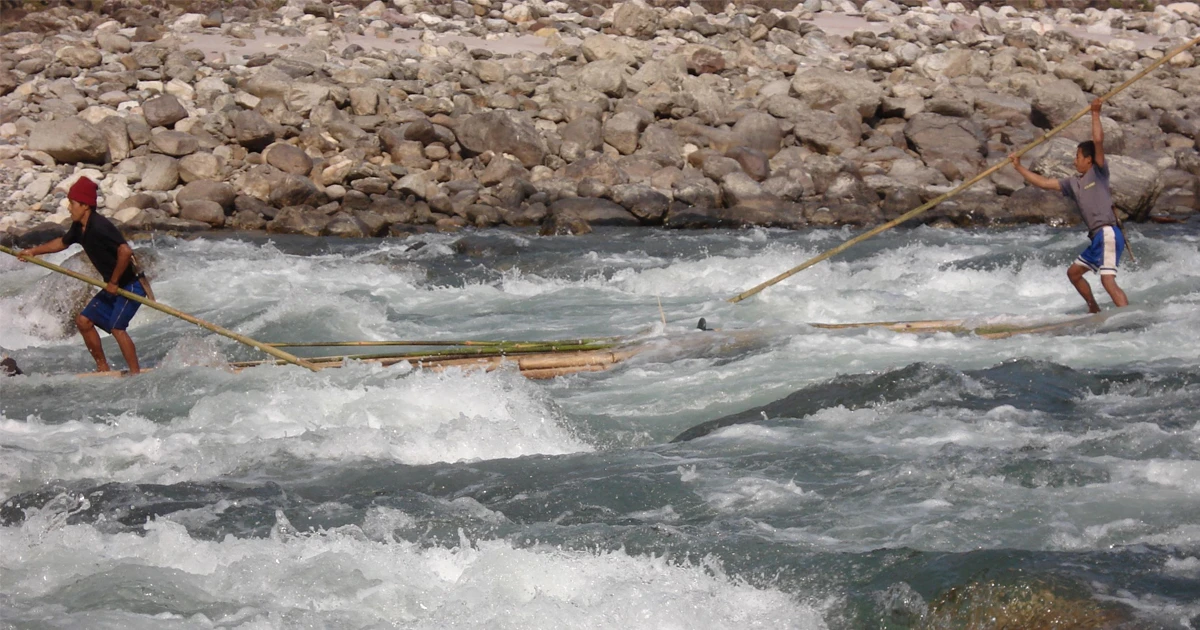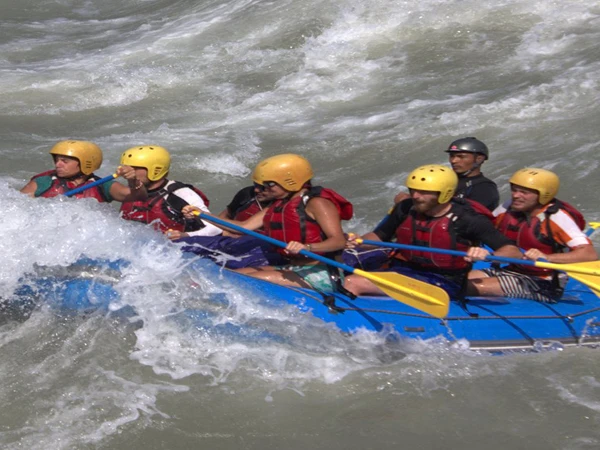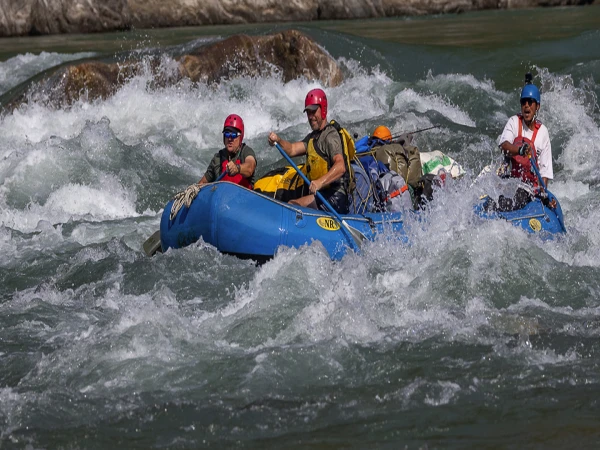The Genesis: Rivers, Geography, and Local Uses (Ancient until mid‑20th century)
Nepal’s grand rivers—the Trishuli, Seti, Bhote Koshi, Sun Kosi, Gandaki/River Marsyangdi, Kali Gandaki, and others—carve deep gorges through Himalayan foothills. For centuries they served local trade, seasonal passage, and subsistence, rather than recreation. Small wooden rafts, dugouts or rafts with plaited bamboo were used by local boatmen to transport salt, grain, pilgrims, and occasionally livestock across tumultuous currents.
- Traditional river craft: Traders and villagers used rafts known as doko-bil or bangda—locally built bundles of bamboo, wood, and rope—primarily on lower reaches. These rudimentary craft were rarely used on steep gorges further north.
- Sacred rivers: Many rivers were revered in Hindu or Buddhist myths—Gandaki for Shaligram fossils, Bhote Koshi near Tibetan border for deities—but recreational use was unheard of.
Thus, while rafting-like methods existed, the concept of deliberately navigating rapids for sport had not yet arrived.
2. Exploration Begins: Surveyors, Mountaineers, and Early Expeditions (1950s–1970s)
Whitewater rafting in Nepal began to gestate during the post‑1950 era, when Nepal opened to the outside world:
- Hydro‑survey and geology teams from India, Britain, and international agencies conducted river mapping and engineering reconnaissance. These teams sometimes used inflatable rafts (mule‑packs, inner‑tube frames) to ferry gear through deep gorges.
- Mountaineering expeditions sometimes included river crossings along base‑camp logistics. Some early trekkers experimented with launching rubber crafts on milder rivers like Trishuli or Marshyangdi for fun.
- However, these were isolated incidents, not organized rafting trips.
Still, awareness began to grow that Nepal’s rivers offered world‑class whitewater not just for transport but for sport, adventure, and tourism.
3. Commercial Pioneers and First Guided Trips (late 1970s–early 1980s)
The first intentional whitewater rafting trips were pioneered in the late 1970s and early 1980s:
- Independent enthusiasts—often foreigners based in Kathmandu or Pokhara—assembled inflatables and gear, scouting Trishuli, Marshyangdi, and Seti rivers.
- The initial licensed operators: A handful of adventurous Nepalese entrepreneurs obtained licenses to guide small groups. They offered half‑day to multiday trips on rivers like Trishuli (grades II–IV), billing them as scenic experiences combined with camping.
- Local training: Guides were pulled from rafting staff of Indian or European trekking companies; they learned rescue skills, paddling techniques, and basic client care.
These early offerings typically featured:
- Inflatable 7‑ or 8‑person rafts with small outboard motors or manual frames.
- Basic camping gear (tent, cooking).
- Routes such as Kurintar – Narayangadh (Trishuli Gorge) guided over one or two days.
- Seasonal operations, especially during November–March (winter season) when rivers were moderate.
4. Technical Refinement and Mid‑1980s Growth
By the mid to late 1980s, rafting in Nepal evolved rapidly:
- River scouting expanded into higher Himalayan tributaries: Groups ran grade IV–V sections of Bhote Koshi and Sun Kosi. Exploratory descents began in 1986–87 by climbing/rafting teams, often supported by British or Swiss adventurers.
- Manufacture of specialized rafts: Nepalese companies started importing European/Dutch ‘raft‑boats’—sleek, aluminum‑skinned, large‑capacity rafts fit for whitewater use.
- Training programs: Guides were certified through collaboration with international institutions like American Canoe Association (ACA), European Rafting Federation, and Himalayan river rescue schools.
- Safety and equipment standards were introduced: mandatory lifejackets, helmets, throw‑bags, rescue lines, first‑aid kits.
This period saw:
- The first week‑long expeditions on remote rivers.
- Camping‑industry synergy: rafting trips coordinated with trekking lodges or tent‑camps.
- The first multi‑river packages marketed to international operators.
5. Landmark Expeditions and Media Publicity (1990s)
The 1990s were transformational—Nepal rafting began to draw global attention:
- Major commercial runs started on the Sun Kosi Grand Canyon—often touted as the “Everest of Rafting.” Five‑ or six‑day trips running 270 km from Dolalghat to Chatara.
- First descent of Bhote Koshi commercial section: In 1993–94, expedition rafts launched on the upper‑reaches gorge between Kodari and Dolalghat, showcasing class V–VI rapids.
- Documentaries, travel shows, magazines: Outdoor magazines such as National Geographic Adventure and travel TV series featured Nepal rafting, using the term “wallet‑emptying rapids”, “Himalayan thunder”, “World‑class whitewater emerges in Nepal”.
- Royal interest: Nepal’s government promoted rafting as a major eco‑tourism development. Regulations were refined; licensing was formalized through the Nepal Tourism Board.
6. Environmental Awareness and Community Engagement (2000s)
In the early 2000s, as rafting boomed, concerns about environmental impact and local community benefits emerged:
- Riverine clean‑up campaigns: Operators organized trash‐pickup campaigns along riverbanks, especially during peak season.
- Community partnerships: Rafting firms contracted with nearby villages for lodging, porters, and meals. Local guides were prioritized.
- Conservation collaborations: Some operators joined with NGOs to preserve river corridors—especially along Kali Gandaki Gorge and Trekking‑rafting loops combining Annapurna foot hills.
Moreover:
- Safety infrastructure improved: Wetsuits, throw‑bags, rescue craft, and standardized training became the norm.
- International certifications: Guides frequently earned ACA raft guide credentials and swiftwater rescue certificates.
- Diversification of trip types: Options broadened: rafting + kayaking combos, family rafting, luxury riverside lodges, corporate outings and team‑building.
7. Modern Era Innovation (2010s through today)
Since 2010, Nepal's whitewater rafting matured into an industry with variety, innovation, and high standards:
7.1 Expanded River Portfolio
- Bhote Koshi: Now offers half‑day adrenaline trips with built‑in canyon jumps. Advertised as world’s steepest commercially rafted river (~100 m drop over 15 km).
- Upper Sun Kosi: Multi‑day, expedition‑style routes extending into Tibet border tributaries.
- Trishuli: Continued to be the most popular for entry‑level and family trips.
- Seti River (Pokhara): Scenic yet challenging sections within Pokhara valley drawing day‑tourists.
7.2 Specialized Experiences
- Luxury rafting: High‑end camps with all‑inclusive service, hot showers, gourmet meals.
- Yeti rafting/adrenaline packages: Combining rafting with bungee jumping, zip‑lining, canyoning.
- Women's adventure groups and LGBTQ trips: Inclusive offerings led by female Nepali lead guides.
7.3 Local empowerment
Many rafting agencies are fully Nepali‑owned, employing local communities, training local rescue teams, and sponsoring scholarships for guide training.
The Nepal Adventure Sports Guide Association (NASGA) helps standardize guide training, sustainability practices, and community returns.
7.4 Technology and Marketing
- Live GPS river tracking, drone‑shot videos shared instantly to clients.
- Online booking platforms, multilingual brochures, and presence on international travel fare aggregators.
- Trip insurance, carbon‑offset options, and COVID‑era hygiene protocols strengthened client confidence.
8. Cultural, Economic, and Ecological Dimensions
8.1 Economic impact and tourism integration
- Rafting generates substantial revenue for river‑flowing regions (Trishuli‑Gandaki area, Pokhara valley, Tatopani).
- Local villagers benefit from employment: cooking, portering, homestay, boat maintenance.
- Rafting is often bundled with trekking, wildlife tours (Chitwan/Bardia), and local festivals (Dashain, Tihar) to extend regional stays.
8.2 Cultural respect and rituals
- Pre‑launch blessings by local priests or shamans at riverbanks is common.
- Rafting teams often stop at riverbank shrines, present offerings, and observe local protocols.
- Many outfitters engage in sponsoring riverside schools, festivals, and conservation education.
8.3 Environmental stewardship
- Operators enforce ’leave no trace’ policies: strict waste disposal, minimal camping footprint.
- Many guide associations mandate river cleanup days each season.
- Partnerships with conservation groups address erosion control, reforestation along riverbanks, and fish habitat repair.
9. Milestone Moments & Notable Expeditions
Year Event
1986 First expedition whitewater descent of upper Sun Kosi expedition route.
1993 Commercial runs begin on Bhote Koshi Gorge.
1998 Sun Kosi Grand Canyon five‑day expedition becomes popular summer package.
2004 Nepal rafting association (informal) formed to adopt best practices.
2010 Introduction of luxury rafting packages with lodges.
2015 First all‑female guiding teams launch women‑only trips.
2020 COVID adaptations: personal PPE, reduced group size, flexible local cancellation terms.
2023 Launch of hybrid rafting+kayaking e‑learning school for swiftwater rescue.
10. Why Nepal’s Rivers Stand Out Today
Nepal’s rivers offer:
- Rare diversity: From grade II beginner stretches to grade V–VI technical canyons, all within hours’ drive from Kathmandu or Pokhara.
- Scenic Himalayan backdrops: High gorges, waterfalls, terraced hills – a visual feast during rapids navigation.
- Cultural immersion: Rivers pass through diverse ethnic communities—Brahmin, Gurung, Magar, Tamang—offering cultural context alongside thrill.
- Year‑round flow: Winter (post‑monsoon) season features clear glacier‑fed water, while monsoon season ramps up adrenaline levels.
- Competitive pricing: Despite global acclaim, Nepal remains affordable compared to rafting in North America, Europe, or Australia.
11. Challenges & The Road Ahead
11.1 Climate change and glacial variability
- Intense glacial outburst floods (GLOFs) and erratic monsoon rains can alter riverbeds and affect run safety.
- Operators now work with hydrologists and local river observatories to monitor flow and issue real‑time updates.
11.2 Carrying capacity and over‑tourism
- Peak season sees high traffic on key rivers, creating strain on campsites and infrastructure.
- Some regions are trialing permit systems and river‑use quotas.
11.3 Maintaining community benefit
- As international firms grow, ensuring local employment and fair revenue share remains a priority.
- Federations like NASGA set ethical standards for profit‑sharing and support for affected villages.
11.4 Safety and global standards
- As more difficult rivers are opened commercially (upper Karnali, Ghunsa feeder), maintaining high safety and rescue protocols is essential.
12. Conclusion & Forward Look
Today, whitewater rafting is deeply embedded in Nepal’s adventure tourism identity. From simple bamboo rafts for trade to multi-day guided expeditions on world-class rapids, it has grown into an industry that highlights both natural majesty and cultural connection.
Looking forward:
- Nepal is set to host international rafting competitions, judge world‑class whitewater festivals, and serve as a training center for Himalayan swiftwater rescue.
- As climate and infrastructure evolve, new river routes—like Karnali upper tributaries—are primed for commercial opening.
- The future lies in balancing thrill with respect: honoring rivers, people, and environment with each paddle stroke.




